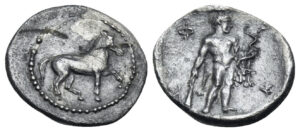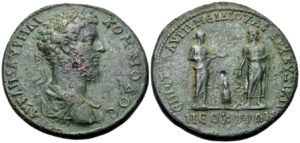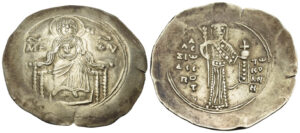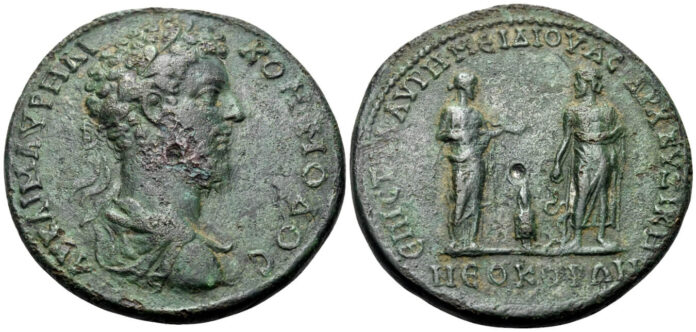Obolos 14 Now Online
Many of you probably think that as soon as Nomos 19 finished, our Dimitris just sat down and began to relax, sipping from his bottle of tsikoudia, eating grilled katsikakia, and chatting away with his pals, mostly fierce-looking Maniote klephts. How wrong could you be! Taking a well-deserved break lasting about an hour, he immediately began working on our next esale, Obolos 14 (closing on 15 December) even though our efficient office staff were still preparing the invoices and packing the lots from Nomos 19! Now it’s finished, and there are 800 intriguing lots of coins and seals for, as they say, your collecting enjoyment! And there are lots of things to enjoy: single and multiple lots containing a wide selection of Greek, Roman, Byzantine, Medieval and early modern coins!

Here is lot 109, a little silver obol from Pharkadon in Thessaly (Starting Price: CHF 150), which must date to the very end of the 5th century (or very early in the 4th). We have a very elegant horse on the obverse, looking like one of those stolen by the Crusaders and now in Venice, and, on the reverse, a remarkably well-made and fine figure of a youthful Herakles in full Classical style. He could easily be from the reverse of a contemporary stater of Abdera: the soigné style and care used to show us this demigod makes it clear that this was not just an ordinary small silver fraction, designed just to pay for a lunch, but was very likely a donative from a rich citizen, made beautifully in order to make paying a pleasure. The reason why this coin does not have a very much higher starting price comes from the scratch and the irregular toning on the obverse.
Turning to one of the many attractive lots of Athenian tetradrachms dating to the 430s and 420s BC, we come to lot 137 (Starting Price: CHF 250): was this actually made in Athens, or is it some kind of contemporary Eastern imitation, perhaps made in Asia Minor rather than in the usual suspect, the Levant? The head of Athena has a slightly odd face, the helmet palmette is very, very unusual, and the owl has slightly curious aspect. Obviously, in order to pay for building and military projects the mint in Athens had begun to crank out enormous quantities of these coins from c. 450 on, with the result that engravers of many different levels of ability had been called in to participate (none were as bad as the “blacksmiths” responsible for the latest pre-Starr issues, but styles and abilities did vary). In any event, this is a bold and attractive coin with a very attractive starting price!
This coin (lot 173, Starting Price: CHF 50), is a very “cute,” very little, 6th century obol from Kyzikos, which has, as its type, a rather cross looking fish. This fish is, of course, the Tuna, or Tunny (Thunnus Thynnus), the source of the city’s prosperity. Why it is shown with six dorsal spines is, presumably, artistic license! So well-struck and well-centered, it is a very nice example!
Why am I highlighting the reverse of this bronze dichalkon from Kolophon (lot 204, Starting Price: CHF 50)? Well, because the engraver who made this die for the magistrate Epigonos did not just show us the usual forepart of a bridled horse, he added quite a lot of the harness as well: there is a band running across the chest leading to what looks like a saddle-cloth of some sort; and what is going on below the cloth? I have contacted our Horse Expert and if she can add some exciting new information on this I will certainly let you know! Sometimes having a good blow up photograph allows you to finally see a type, so that long unnoticed details become apparent.

The coinage of Rhodes is well-known for the great variety of heads of Helios it bears, especially because of the wildly differing abilities of its engravers, and the influence of the artistic style that prevailed at the time they worked. You have severe and full Classical heads, as well as more florid and emotional late Classical and Hellenistic ones; here is one: This is lot 228. (Starting Price: CHF 150), a Rhodian drachm of the later 1st century BC, signed by the magistrate Basileides: if this late Hellenistic chap isn’t florid and emotional, who is? We have several different, equally fine examples from this series, all with differing heads – why not collect them all?
When we say the name Medusa, we immediately get a vision of the hideously fierce face of the Gorgon whose head was cut off by Perseus: so how can this lovely winged head be hers? Struck in Sardes by Seleukos I in BC 282/1 (lot 290, Starting Price: CHF 100), this bronze has, on its obverse, a winged female head, apparently adorned by snakes yet of serene beauty. According to myth, Medusa was originally a very beautiful young woman, pursued by numerous suitors, who she apparently spurned; however, in an action with some present-day relevance, Poseidon, rapt with passion, raped her in a temple to Athena. Instead of punishing Poseidon, an enraged Athena punished Medusa (!) and turned her into a monster. This does seem to be remarkably unfair, in true blame the victim fashion; and why is she here? Does it refer to some now lost local myth?

As everyone knows, Roman Provincial coins were struck from dies made by engravers of widely varying abilities, ranging from apprentice blacksmiths to absolute masters, fully equal in skill to the best working for the mint in Rome. This is a perfect example: Lot 340 (Starting Price: CHF 500), is a very large, 42 mm diameter, bronze of Commodus from Cyzicus, probably, from the style of the portrait, struck in the mid to late 180s. Termed a medallion by our cautious cataloguer – the modern successor of his equally erudite namesake Demetrios Kydones – it is probably the local equivalent of a piece of 8 assaria (= a quinarius), minted for donative use. The superbly careful engraving is astounding: the portrait of Commodus is truly noble, reminiscent of some busts of his father, but sterner, less intellectual and more unbending. On the reverse we have the very well-made and sober figures of Asclepius with his serpent staff, his daughter Hygieia with her snake, and his dwarf-like son Telesphorus in his Klan robes. Notable as well are the legends, which are beautifully done.

Jumping forward, far forward, the last coin of today is a post-reform aspron trachy of Alexius I, dating to 1092-1118 (lot 641, Starting Price: CHF 200). Interestingly enough, these coins are surprisingly uncommon, especially when well-struck and in nice condition, as this is. On the obverse we have the Virgin holding a medallion bearing a portrait of the infant Christ – on the reverse is the emperor accompanied by his titles. It is noteworthy that Alexius holds a scepter of what might be termed secular form, since it lacks a cross. Compared to all the other emperors following the death of Basil II in 1025, Alexius was exceedingly competent, militarily able and practical. If the Empire had continued to be ruled by the divisive, cultured and pious nonentities that had dominated the state for the previous 55 years, it might have succumbed far sonder than it did.
You can watch the lots on NumisBids, Biddr, Sixbid and of course on the Nomos website. The Webauction will be live exclusively on the Nomos website.





